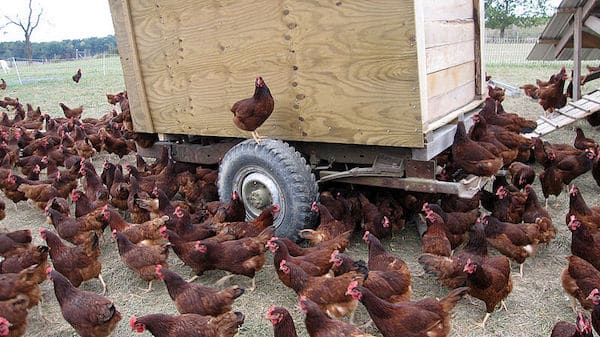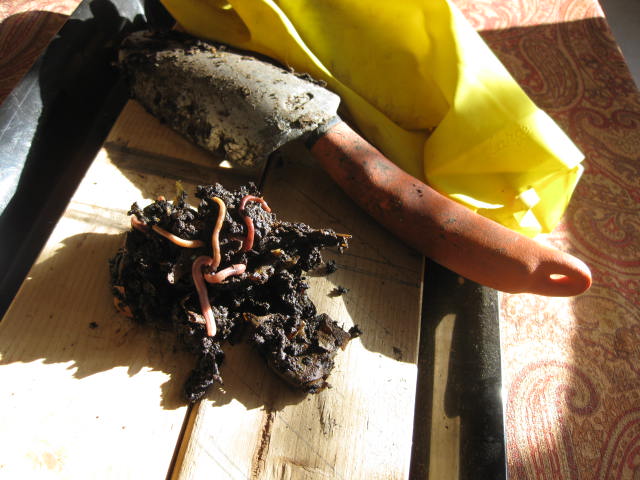Updated: April 15, 2020
What are chicken tillers? No they are not a new brand of tiller.
Chicken tillers are smart people who use their chickens to get ready for planting by having them clear the area of vegetation and cover crop. As an added bonus, chickens fertilize the garden, too.
And you know what? They like doing it.
Let’s take a sec to get the legal words out of the way. This article may contain affiliate links. That means if you click and buy from my partners, I will make a tiny amount of money. This in no way affects my recommendations.
Let chicken tillers do the hard work
When it comes to growing food, I really like the idea of having your animals or the microorganisms do the hard work for you.
I was first favorably exposed to this idea when reading about Joe Salatin and his Polyface Farm.
Since then, I’ve written a related article about encouraging beneficial insects to combat your insect pests and improve pollination. Plus, I wrote about using microorganisms to make kefir.
This is all in the spirit of aligning yourself with natural processes so you don’t have to fight nature.
Another article in this vein is growing cover crop, which discusses a very inexpensive way to improve the soil.
When it comes to cover crop, I’ve always thought that turning it by shovel or power tiller damaged the soil structure and adversely affected the beneficial organisms in the dirt. But I didn’t know a better way to prepare my backyard beds for planting.
The rapid increase in [soil] quality is an order of magnitude beyond anything you can do with a power tiller.
— Harvey Ussery
So it’s no wonder that I was interested when I read about using chickens to “till” cover crop in Harvey Ussery’s The Small-Scale Poultry Flock.
Ussery suggests that chickens are a better way to prepare your beds.
He says that “if you leave [chickens] in one place long enough, they will kill the sod. Ah, but if you leave them in one place long enough, they WILL kill the sod.”
The result of chicken tilling is ground that has:
- Been stripped of cover crop or other vegetation.
- A top inch or so of loose dirt.
- Cover crop roots left in place to provide organic matter for microorganisms and water retention.
- Been fertilized with high nitrogen chicken manure.
How to till with chickens
You could save a lot of work by:
Step One: Use chicken tillers to prepare a bed of weeds for planting.
Step Two: Plant cover crop after chicken tilling and letting it grow.
Step Three: Shred the cover crop using chicken tillers.
Step Four: Plant your vegetables.

How Many Chickens?
The big questions are how many chickens will it take and how long before you can plant?
Obviously, the more chickens you use, the less time it will take. The good news is if you have a small garden a few chickens can take care of the task pretty quickly.
My estimate, based on Ussery’s figures, is two birds could easily scratch up 100 square feet in about two to three weeks. It could be more or less depending on the chickens and the ground conditions.
Another thought is that chicken tillers can do more than just live vegetation. They can do any organic matter, for example, compost, horse manure or grass clippings.

How to Improve Soil
All the ways I know to improve your soil.
Better than a power tiller
Of course, the downside is it takes weeks for chickens to do what a power tiller can do in a day or two.
But it turns out that a man armed with fossil fuels and heavy machinery can’t do it as well as tiller chickens. Ussery reports that “the rapid increase in [soil] quality is an order of magnitude beyond anything you can do with a power tiller.” In other words, you get the benefits of no till farming, but with slightly turned ground.
It wouldn’t be the first time that the natural way of growing food has turned out to be better than the man-made way.
Related articles you might enjoy:
Suburban Hobby Farmer is a participant in the Amazon Services LLC Associates Program, an affiliate advertising program designed to provide a means for sites to earn advertising fees by advertising and linking to amazon.com.